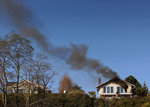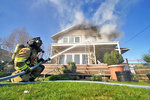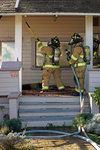Had three men not jumped into action upon spotting black smoke in the sky on Thursday, Nov. 13, fire officials say, flames likely would have consumed much more of a historic Port Townsend …
This item is available in full to subscribers.
We have recently launched a new and improved website. To continue reading, you will need to either log into your subscriber account, or purchase a new subscription.
If you had an active account on our previous website, then you have an account here. Simply reset your password to regain access to your account.
If you did not have an account on our previous website, but are a current print subscriber, click here to set up your website account.
Otherwise, click here to view your options for subscribing.
* Having trouble? Call our circulation department at 360-385-2900, or email our support.
Please log in to continue |
|





Had three men not jumped into action upon spotting black smoke in the sky on Thursday, Nov. 13, fire officials say, flames likely would have consumed much more of a historic Port Townsend house.
“We always caution people to be careful, but certainly we appreciate their help in this instance,” Bill Beezley, public information officer for East Jefferson Fire Rescue (EJFR), said of the second-story structure fire at the 101-year-old George and Mary Starrett House at 419 Quincy St. “They may have made a pretty significant contribution to getting this fire out so quickly.”
Upon driving from the Northwest Maritime Center to the Point Hudson Marina to help launch the recently repaired Martha J – a 22-foot Pulsifer Hampton – the center’s boat shop manager, Scott Jones, looked up and said to his passengers, “Hey, that looks like a house fire.”
“You could see the fire had just broken out of the building,” said John Anderson, a 60-year-old volunteer at the center who moved to Port Townsend two years ago upon retiring from a 32-year fire fighting career with the Berkeley Fire Department in California. “We thought someone might be inside, so we went blasting up there.”
As Jones drove up Monroe Street at 12:40 p.m., Anderson dialed 911.
At the same time, a young girl at Kris Logue’s Castle Hill Preschool – located directly across the dead-end street from the burning house – turned to Logue and said, “Teacher, that house is on fire,” as she and her classmates poured into the fenced-off yard for recess.
Logue asked, “What did you say?” and the girl repeated herself clearly, pointing across the street. At 12:42 p.m., Logue called 911.
“They were in awe,” she said of her 15 preschoolers.
Within another minute, as preschoolers stopped to watch flames flare and smoke billow, Anderson, Jones and Jessiah Worley raced onto the scene.
“When we got there, we saw the fire was confined to the second-story bedroom and had broken out one of the windows,” said Anderson, who learned from Logue that no one was inside the house. “It was venting out of the room and starting to catch the eave of the roof.”
Anderson ran to the house’s backyard, grabbed a garden hose and started spraying, while Jones and Worley ran around the house, checking windows and banging on doors for any sign of people or animals inside.
“It was so surreal,” said 24-year-old Worley, who lives in Port Orchard and works weekdays in the Northwest Maritime Center’s boat shop. “You see this kind of thing on the news, and all of a sudden it’s real and I’m dealing with it. It was just so unexpected.”
Jones grabbed a ladder and propped it against the house, allowing Anderson to climb closer to the flames with the garden hose in hand.
“It’s amazing what you can do with a garden hose,” Anderson said. “The eave [edge of the roof] directly above the fire was burning when I got up there, and I was able to put that out. If I hadn’t done that, the fire would have probably gotten into the attic before the firefighters got there.”
If left to burn, Beezley said, a structure fire will double in size roughly every minute.
“All he could do is wet things down and slow its growth,” Beezley said of the garden-hose spray. “He slowed its growth, and that allowed us time to get in there and put it out.”
Anderson said it wasn’t long before the garden hose could no longer contain the flames.
“Using that garden hose was beneficial for a period of time, but became useless after a while as the fire spread,” he said. “I bought the fire department a little bit of time. I was worried about those other windows breaking out, so I climbed back down.”
Fire Engine 16 arrived on the scene from the Uptown station on Lawrence Street at 12:47 p.m. Anderson helped roll out fire hose and hold the line as EJFR firefighters began a transitional attack, in which they simultaneously apply water inside and out.
More than 20 emergency responders from EJFR, Naval Magazine Indian Island, Port Ludlow Fire & Rescue and the chief from Quilcene Fire Rescue responded. The fire was under control by 1:05 p.m. and out by 1:20 p.m.
“Our first units did a superb job,” Beezley said. “They responded to an active structure fire in a historic home, which tend to burn fairly quickly, and they limited the flame damage to the second story of the structure.”
A Jefferson County Public Utility District crew responded, shutting off power to the house and several others in the area before firefighters entered the house. Power was turned back on at about 2 p.m.
Once firefighters had taken over the scene, Anderson, Jones and Worley headed back to the Point Hudson Marina to launch the Martha J.
“We didn’t hang around because we had that boat to launch,” Anderson said. “I helped one of the firefighters hold the line for a little while and then we shook hands, and I grabbed Scott and Jessiah and took off. We were burning daylight. Plus, all the fun was over anyway.”
Parents of preschoolers began arriving to pick up their children as firefighters sprayed water and moved through the inside of the house.
One boy began crying, nervous for firefighters inside the house whom he had mistaken for children.
Firefighters inside the structure not only used fire hoses to suppress the flames, but also poked holes in the roof to allow smoke to escape.
Although responders were able to limit the fire to the second story, Beezley said, the house’s first floor suffered some damage from smoke, water and firefighter foot traffic.
The Jefferson County Fire Investigation Task Force gathered immediately after the fire was extinguished to begin an investigation into its cause.
After speaking with the owners of the home – Aaron Von Awe, 71, and Cathie Von Awe, 67 – by phone on Thursday, Beezley said they did not know how the fire might have started. The Von Awes had not been home during the fire.
By the following day, the task force determined that power strips and extension cords had apparently overloaded upstairs electrical outlets. Investigators suspect the fire had smoldered for possibly as long as a day or two before breaching the house’s walls.
The house is a registered historic property with Washington’s Department of Archaeology and Historic Preservation. Because of its age, Beezley said, “it could have turned out significantly worse if [responders] hadn’t gotten into it quickly.”
After the fire was extinguished, a company called 1-800-BoardUp placed wooden boards over the broken windows and walls opened up by fire damage.
The next day, Beezley and Assistant Fire Chief Brian Tracer paid a 20-minute visit to Logue’s preschoolers, telling them about the fire they’d witnessed, showing them the equipment that firefighters wear and use, passing out plastic fire helmets and boxes of crayons, and teaching them to “get low and go” when caught inside a structure fire.
“The kids were so good about the situation,” Logue said. “The firemen thanked them and shook their hands.”
Logue said she was impressed with Anderson, Jones and Worley’s quick response.
“Who does that?” Logue asked, pointing out that most people stood back and watched. “Who goes out of their way to help like that?”
Anderson said that if Logue had suspected someone was inside, “We would have gone in and tried to do a rescue.”
“We got up there and we took care of business,” Anderson said. “Why not? You’ve got to do something, right?”